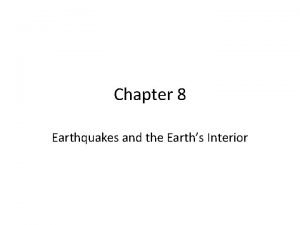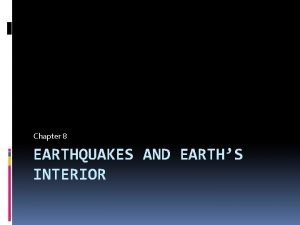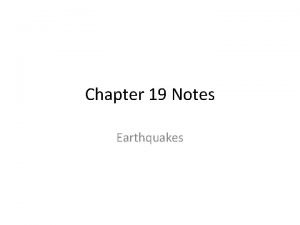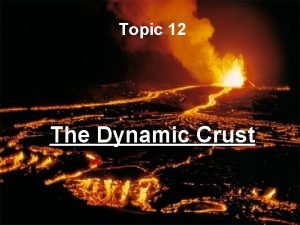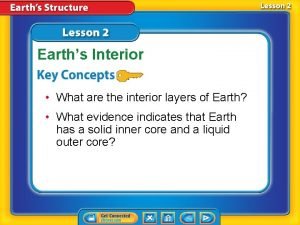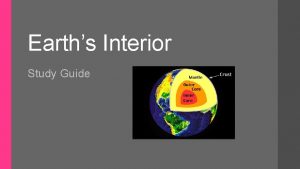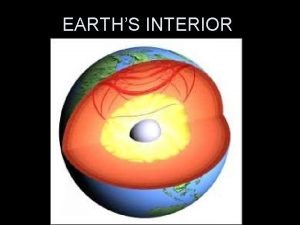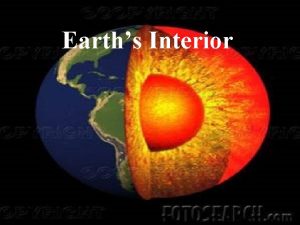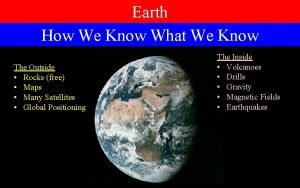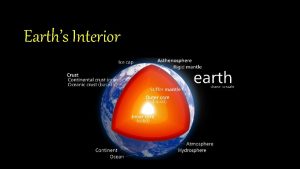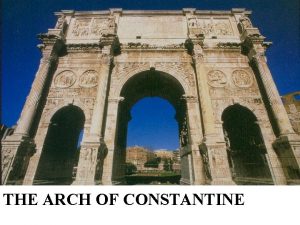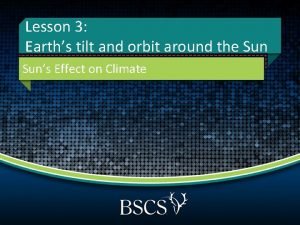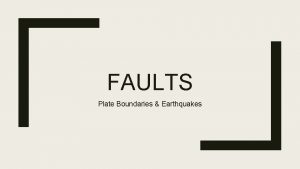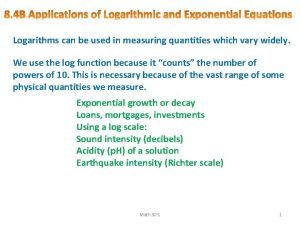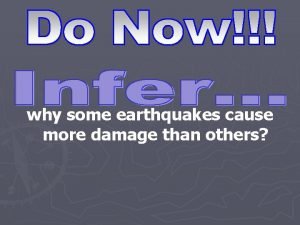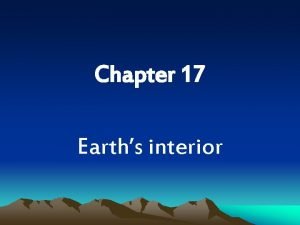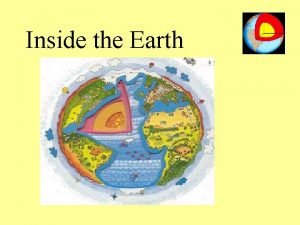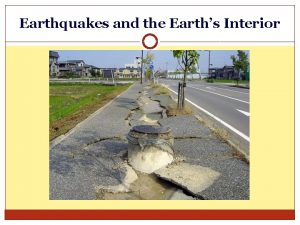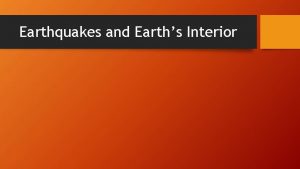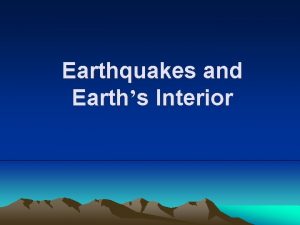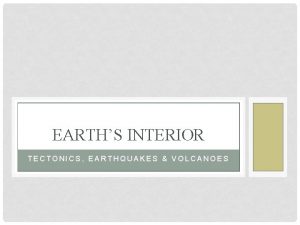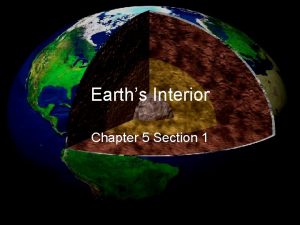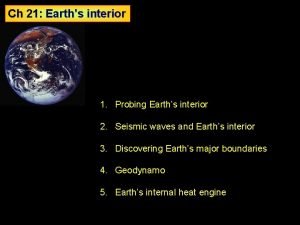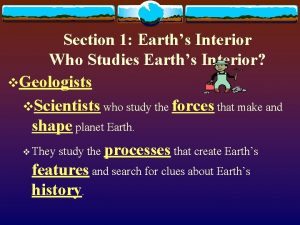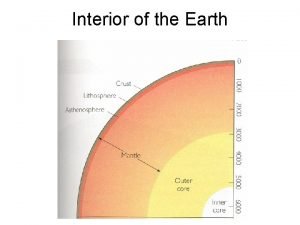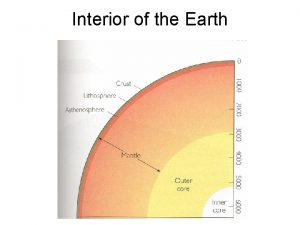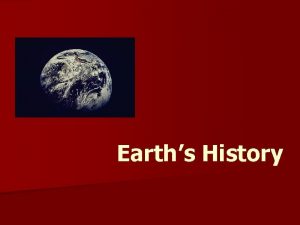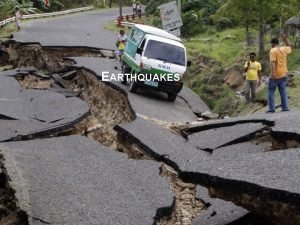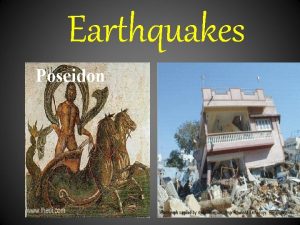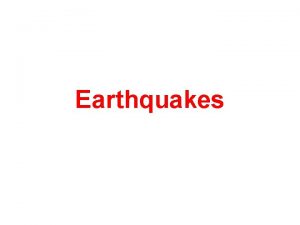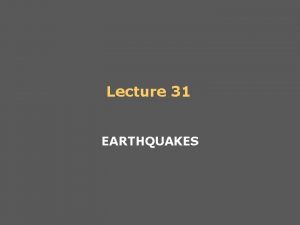Earth Science 101 Earthquakes and Earths Interior Chapter













































- Slides: 45

Earth Science 101 Earthquakes and Earth’s Interior Chapter 7 Instructor : Pete Kozich

Earthquakes v. General features • Vibration of Earth produced by the rapid release of energy • Associated with movements along faults • Explained by the plate tectonics theory • Mechanism for earthquakes was first explained by H. Reid • Rocks "spring back" – a phenomena called elastic rebound • Vibrations (earthquakes) occur as rock elastically returns to its original shape

Elastic rebound Figure 7. 5

Elastic Rebound

Earthquakes v. General features • Earthquakes are often preceded by foreshocks – small earthquakes preceding a major earthquake by days perhaps even a year • and followed by aftershocks – adjustments following major earthquakes in the form of small quakes

Earthquakes v Earthquake waves • Study of earthquake waves is called seismology • Earthquake recording instrument (seismograph) Records movement of Earth Record is called a seismogram

Seismograph Figure 7. 6

Seismographs

Earthquakes v Types of earthquake waves • Surface waves • Complex motion (up/down and side-to-side motions) • Slowest velocity of all waves • Body waves (travel through the interior of the Earth) • Primary (P) waves • Push-pull (compressional) motion • Travel through solids, liquids, and gases • Greatest velocity of all earthquake waves • Secondary (S) waves • "Shake" motion (transverse waves) • Seismically generated ones travel only through solids • Slower velocity than P waves, but faster than surface waves

A seismogram records wave amplitude vs. time Figure 7. 7

Surface waves

Primary (P) waves Figure 7. 8 B

Secondary (S) waves Figure 7. 8 D

Earthquake Waves

Earthquakes v. Locating an earthquake • Focus The place within Earth where earthquake waves originate • Epicenter • Point on the surface, directly above the focus • Located using the difference in the arrival times between P and S wave recordings, which are related to distance • Three station recordings are needed to locate an epicenter • Circle equal to the epicenter distance is drawn around each station • Point where three circles intersect is the epicenter

Earthquake focus and epicenter Figure 7. 2

A time-travel graph is used to find the distance to the epicenter Figure 7. 9

The epicenter is located using three or more seismic stations Figure 7. 10

Earthquakes v. Locating an earthquake • Earthquake zones are closely correlated with plate boundaries • Circum-Pacific belt • Oceanic ridge system

Magnitude 5 or greater earthquakes over a 10 year period Figure 7. 11

Earthquakes v. Earthquake intensity • Intensity • A measure of the degree of earthquake shaking at a given locale based on the amount of damage • Most often measured by the Modified Mercalli Intensity Scale

Earthquakes v Earthquake magnitude • Magnitude • Concept introduced by Charles Richter in 1935 • Often measured using the Richter scale • Based on the amplitude of the largest seismic wave • Each unit of Richter magnitude equates to roughly a 32 fold energy increase • Does not estimate adequately the size of very large earthquakes • Moment magnitude scale • Measures very large earthquakes • Derived from the amount of displacement that occurs along a fault zone

Earthquakes v Earthquake destruction • Factors that determine structural damage Intensity of the earthquake Duration of the vibrations Nature of the material upon which the structure rests The design of the structure • Destruction results from • Ground shaking • Liquefaction of the ground • Saturated material turns fluid (acts like quicksand) • Underground objects may float to surface • Tsunami, or seismic sea waves • Landslides and ground subsidence • Fires

Damage caused by the 1964 Anchorage, Alaska earthquake Figure 7. 14

The Turnagain Heights slide resulted from the 1964 Anchorage, Alaska earthquake Figure 7. 21

Formation of a tsunami Figure 7. 18

Fig. 7. 24, p. 170

Tsunami

Tsunami travel times to Honolulu Figure 7. 20

Earthquakes v. Earthquake prediction • Short-range – no reliable method yet devised for short-range prediction • Long-range forecasts • Premise is that earthquakes are repetitive • Region is given a probability of a quake

Fig. 7. 21, p. 166

Earth's layered structure v. Most of our knowledge of Earth’s interior comes from the study of P and S earthquake waves • Travel times of P and S waves through Earth vary depending on the properties of the materials • S waves travel only through solids

Possible seismic paths through the Earth Figure 7. 24

Earth's layered structure v Layers defined by composition • Crust • Thin, rocky, light outer layer (generally solid) • Varies in thickness • Roughly 7 km (5 miles) in oceanic regions • Continental crust averages 35 -40 km (25 miles) • Exceeds 70 km (40 miles) in some mountainous regions • Continental Crust • • Upper crust composed of granitic rocks (silica rich, felsic) Lower crust is more akin to basalt (andesitic and mafic) Average density is about 2. 7 g/cm 3 Up to 4 billion years old • Oceanic Crust • Basaltic composition • Density about 3. 0 g/cm 3 • Younger (180 million years maximum) than the continental crust

Earth's layered structure v. Layers defined by composition • Mantle Below crust to a depth of 2900 kilometers (1800 miles) Composition of the uppermost mantle is the igneous rock peridotite (changes at greater depths); olivene rich • Outer Core • • Below mantle Radius of 3486 km (2161 miles) Liquid, Composed of an iron-nickel alloy Average density of nearly 11 g/cm 3

Earth's layered structure v. Layers defined by physical properties • Lithosphere Crust and uppermost mantle (about 100 km thick) Cool, rigid, solid • Asthenosphere • Beneath the lithosphere • Upper mantle to a depth of about 660 kilometers • Soft, weak layer that is easily deformed

Earth's layered structure v. Layers defined by physical properties • Mesosphere (or lower mantle) 660 -2900 km More rigid layer Rocks are very hot and capable of gradual flow • Outer core • Liquid layer • 2270 km (1410 miles) thick • Convective flow of metallic iron within generates Earth’s magnetic field; very dense

Fig. 7. 30, p. 175

Earth's layered structure v. Layers defined by physical properties • Inner Core • • Sphere with a radius of 1216 km (754 miles) Behaves like a solid Contains Iron and Nickel Very dense

Views of Earth’s layered structure Figure 7. 25

Earth's layered structure v. Discovering Earth’s major layers • Discovered using changes in seismic wave velocity • Mohorovicic discontinuity Velocity of seismic waves increases abruptly below 50 km of depth Separates crust from underlying mantle • Shadow zone • Absence of P waves from about 105 degrees to 140 degrees around the globe from an earthquake • Explained if Earth contained a core composed of materials unlike the overlying mantle

Seismic shadow zones Figure 7. 26

Earth's layered structure v. Discovering Earth’s major layers • Inner core • Discovered in 1936 by noting a new region of seismic reflection within the core • Size was calculated in the 1960 s using echoes from seismic waves generated during underground nuclear tests

Earth's layered structure v. Discovering Earth’s composition • Oceanic crust • Prior to the 1960 s scientists had only seismic evidence from which to determine the composition of oceanic crust • Development of deep-sea drilling technology made the recovery of ocean floor samples possible

Earth's layered structure v Discovering Earth’s composition • Mantle Composition is more speculative Lava from the asthenosphere has a composition similar to that which results from the partial melting of a rock called peridotite • Core • Evidence comes from meteorites • Composition ranges from metallic meteorites made of iron and nickel to stony varieties composed of dense rock similar to peridotite • Iron, and other dense metals, sank to Earth’s interior during the planet’s early history (mass sorting due to gravity) • Earth’s magnetic field supports the concept of a molten outer core • Earth’s overall density is also best explained by an iron core
 Chapter 8 earthquakes and earth's interior
Chapter 8 earthquakes and earth's interior Chapter 8 earthquakes and earth's interior answer key
Chapter 8 earthquakes and earth's interior answer key Where
Where In what section of earth do earthquakes happen?
In what section of earth do earthquakes happen? A large crack in the earth formed by a river or earthquakes
A large crack in the earth formed by a river or earthquakes Chapter 8 section 1 what are earthquakes
Chapter 8 section 1 what are earthquakes Chapter 8 earthquakes and volcanoes
Chapter 8 earthquakes and volcanoes Chapter 19 earthquakes
Chapter 19 earthquakes Chapter 19 earthquakes
Chapter 19 earthquakes Topic 12 earth's dynamic crust and interior
Topic 12 earth's dynamic crust and interior How did deep mines and wells give clues to earth's interior
How did deep mines and wells give clues to earth's interior What s your favourite subject
What s your favourite subject How do geologists study direct evidence of earth's interior
How do geologists study direct evidence of earth's interior To study earth's interior geologists often rely on
To study earth's interior geologists often rely on Earth's interior
Earth's interior Earth's interior
Earth's interior Earth interior
Earth interior Earths layers foldable
Earths layers foldable Earths roation
Earths roation Whats earths moon called
Whats earths moon called Earths biomes
Earths biomes Most common elements in the earth's crust
Most common elements in the earth's crust Basalt
Basalt Whats earths moon called
Whats earths moon called Earth's thickest layer
Earth's thickest layer Earths early atmosphere contained
Earths early atmosphere contained Which layers together constitute the lithosphere
Which layers together constitute the lithosphere Earths major crustal plates
Earths major crustal plates Earths orbit seasons
Earths orbit seasons Brown earth soil ireland
Brown earth soil ireland Study of earth's physical features
Study of earth's physical features Honey as fertilizer for plants
Honey as fertilizer for plants What is luna moon
What is luna moon Earths mantle
Earths mantle Earths crust
Earths crust Spring earth tilt
Spring earth tilt Atmosphere definition science
Atmosphere definition science Describe the true shape of earth's orbit
Describe the true shape of earth's orbit Earths kayers
Earths kayers What does earths tilt do
What does earths tilt do Earths boundaries
Earths boundaries Earths 4 spheres
Earths 4 spheres Btn earthquakes
Btn earthquakes Explain natural disasters
Explain natural disasters Http://earthquake.usgs.gov/earthquakes/map/
Http://earthquake.usgs.gov/earthquakes/map/ Why do some earthquakes cause more damage than others
Why do some earthquakes cause more damage than others
